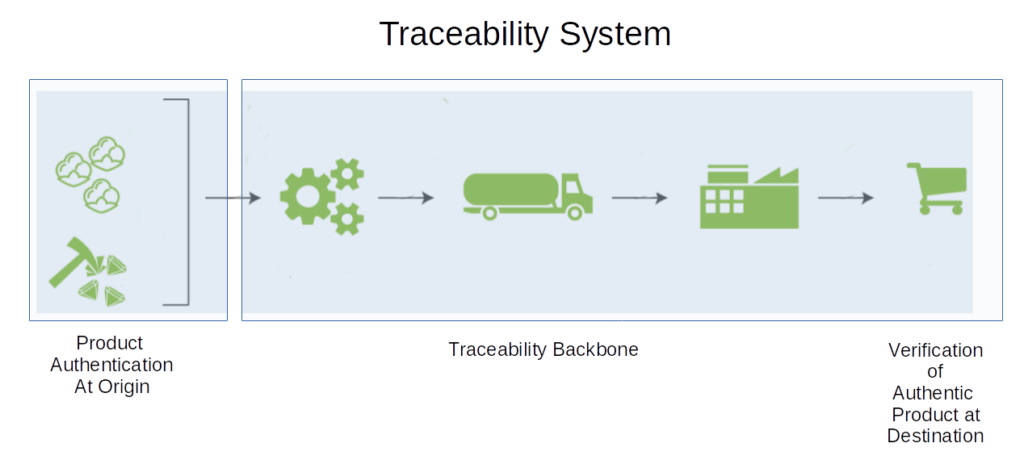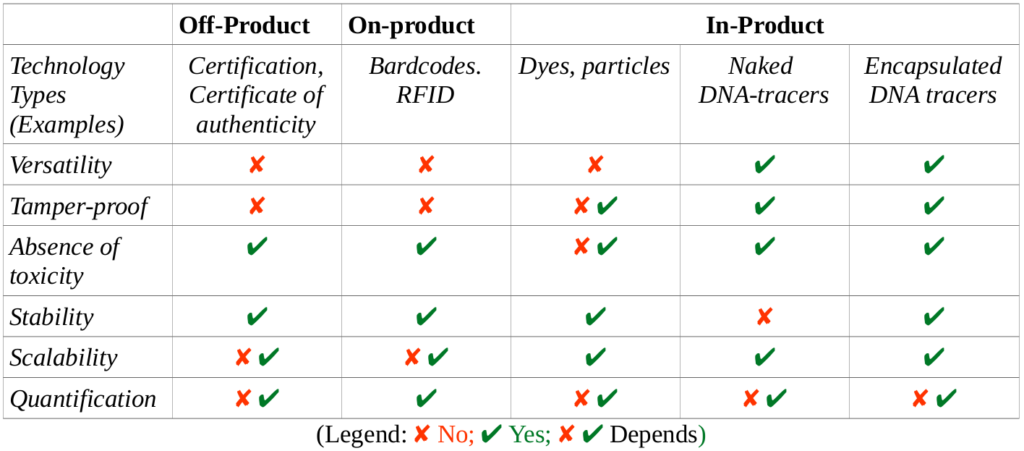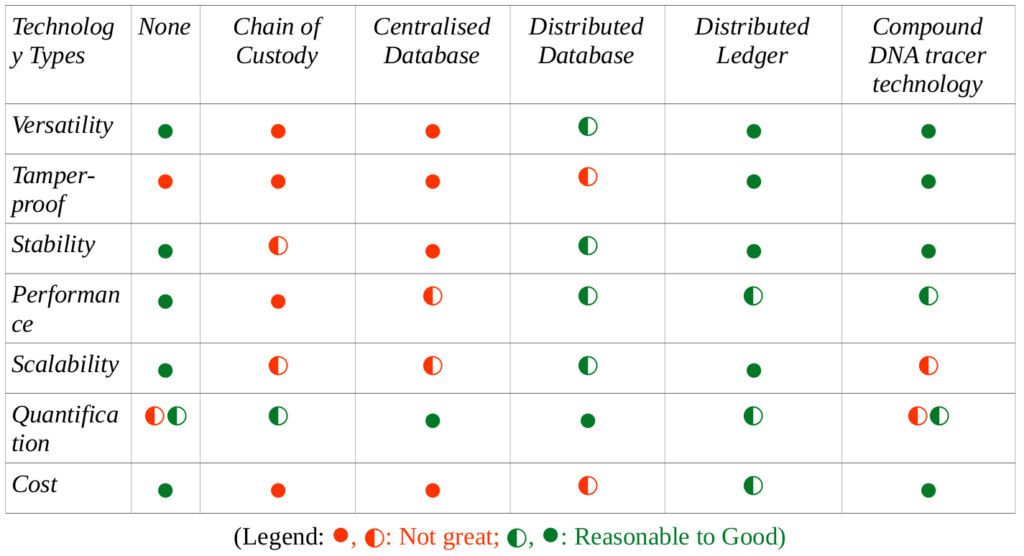This article appeared in shortened and edited form in Ecotextile News Edition of June/July 2019.
Authentication and traceability backbone solutions have become a key technology for many a brand to prevent not only product forgery, but also to prove truthfulness of on-and-off product claims.
What few realise: product authentication is just one half of a 2-part system (Figure 1) whereby authentication is applied to the product at its point of origin, and a traceability backbone ensures that the product reaches its destination – for example the end consumer – safely and untampered.

However, the need for more stringent product authentication at point of origin and subsequently throughout the system, including that of commodity materials such as cotton, has become evident over the last few years, as a range of scandals has hit the headlines:
- the Welspun scandal (sale of falsely labelled Egyptian cotton products)
- the discrepancies between sewn product output labelled organic vs total international organic, or
- the sale of GM cotton as ‘organic’.
DNA -based approaches have been identified as one novel highly promising solution to this challenge. When it comes to textile applications though, the use of DNA tracers is still in its infancy, and currently multiple parallel efforts are under way to pressure test the technology’s robustness, scalability and easy-of-use in mainstream textile processing scenarios. Examples of such efforts are: the Egyptian Cotton Pilot, the Organic Cotton Traceability Pilot (a multi-party effort including the Organic Cotton Accelerator, Fashion for Good and the C&A Foundation), the Cirkularity project for rPET or the Leather Traceability Pilot.
In the remaining of this article we compare the range of solutions available for product authentication on the one hand, as well as those available for the traceability backbone on the other. In this way, emergent DNA tracing technology is compared to already existing, and at this very moment still more established competing approaches.
Product Authentication Approaches
On first sight, product authenticity – or in more mainstream terminology: avoidance of product forgery – and truthfulness of e.g. sustainability claims, have preciously little in common. However, from a customer’s perspective they are surprisingly similar, because it is all about:
- Getting what you pay for: in one case a product that is indeed made by and through the craftsmanship a brand stands for; and in the other, a real contribution to the social and/or ecological benefits a ‘better’ product promises.
- Avoidance of fraudulent tampering: with either the product, the ingredients thereof, or its production, in order to make a quick buck through criminal and purely greedy behaviour, and hence with no concern for the damage to the livelihoods of other.
- Lack of respect (coupled with criminal behaviour): by criminal actors for Intellectual Property, Savoir Fair of the maker, and the intent and pride of the buyer.
- Compliance with consumer product legislation: Claims on the product must be proven to be truthful and accurate.
As mentioned above: over the decades, a range of increasingly sophisticated solutions have come into existence, such as authenticity certificates, product registration mechanisms, or unique and nearly impossible to replicate production techniques to just name a few. Some of those inventions have managed their way into the mainstream, albeit with varying degrees of uptake and success. The currently existing techniques and approaches typically fall into one of three categories:
- Off-Product: The identifier is supplied on a medium that is provided alongside the product at its place of origin, and accompanies it going forward. Examples are: certificates of authenticity, or audit certificates.
- On-Product: The identifier is supplied ‘onto the product’ at its place of origin, and going forward forms a unit with the product. It can however be removed through physical force or chemical process. Examples are: care engine serial numbers, or embossing in bank notes. A typical example from the textile space are barcodes and RFID tags under the GS1 Standard (for more details: cf: October/November 2015 issue of Ecotextile News, page 64).
- In-Product: The identifier is embedded into the product at its place of origin, and the unification with the product can typically only be dissolved by physically destroying the product.
Over the last 2 to 3 years, DNA-science based innovation approaches originating in biology and/or forensics, have found application in ‘In-product’ authentication. For example, the new normal for medical and textile Cannabis may potentially be the use of a master database of ‘DNA of Origin’, against which any on-market sample may be compared against to assess its legal legitimacy status.
As a consequence, at this very moment the In-Product authentication category has expanded from historically 1 type (bullet point 1 hereafter), to 3 subcategories, as follows:
- Dyes, tags/particles: Typical examples would be technologies such as special identification threads embedded in bank notes, or physical tags embedded into a synthetic fibre during extrusion.
- Naked DNA Tracers: Synthetic DNA segments are added ‘as is’ onto/into the surface texture of a product at nano-level, and can then be read out by taking and analysing samples (e.g. via swabs) from the treated surface.
- Encapsulated DNA tracers: Synthetic DNA segments are encapsulated at nano level into a carrier medium, and then applied – similar to the naked version – onto/into the surface texture of a product. As above, they then can be read out by taking and analysing samples (e.g. via swabs) from the treated surface.
Table 1 summarises the pros and cons of the different available as well as emerging product authentication approaches:

Traceability Backbone Approaches
When it comes to technologies that provide for the traceability backbone (right hand side in Figure 1), they typically fall into one of the following categories:
- None = No separate backbone; only product authentication at origin: The whole system relies entirely on the product authentication being tamper proof. Common market mechanisms are used for products to reach their final destination. Examples: GMO -based commodities (certain cotton or wheat types).
- Chain of Custody: refers to the chronological documentation (also called: paper trail) that records the sequence of custody, control, transfer, analysis, and disposition of physical or electronic evidence (Source) in order to track authenticated products through to their destination. Information held by independent and non-interacting players must be first explicitly collected centrally, followed by a consolidation step that allows for the creation of an origin-to-destination trail for the product. Example: Current status for certified organic cotton.
- Centralised Database: is a database that is located, stored, and maintained in a single location (Source). Any data and data updates need to be taking place on this one physical unit, by a authorised entity. Information held by independent and non-interacting parties must be entered by each of these parties – manually or automatically – into the database in order to create an origin-to-destination trail for the product. Example: Tax identification numbers of citizens in a specific country.
- Decentralised / distributed approaches (2 subcategories):
- Distributed Database: In contrast to the approach outlined above, this is a database system that consists of multiple loosely coupled sites that share no physical components (Source). Information held by independent and non-interacting authorised parties must be entered by each of these parties – manually or automatically – into one of the distributed database units. The database software then sees to the information being propagated/replicated across the system, in order to create an origin-to-destination trail for the product. Example: Domain-Name Servers (‘internet phone book’) that match web addresses to their respective IP numbers.
- Distributed Ledger: is a distributed database system that functions via a geographically distributed peer-to-peer network as well as a consensus algorithms to ensure data replication across the disperse locations. One form of distributed ledger design is the blockchain system (Source, Source). Information held by independent and non-interacting authorised parties must be sent by each of these parties – automatically – into one of the distributed database units. Similar to financial accounting, any such interaction is journaled. Further, already entered information cannot be altered retrospectively, but only ‘updated’ by adding a new journal entry with corresponding information. The consolidation of the journal entries avoids fraud, and at the same time creates an origin-to-destination trail for the product. Example: Gubelin Gem Lab Paternity Test.
- Compounded Product Authentication: Rather than being a ‘typical’ traceability backbone, a DNA tracer authentication technology is used throughout. By adding a tracer that is unique to each processing facility, at each processing step to the product, authenticity can be preserved, and the origin-to-destination trail secured. This approach is currently only available at lab scale and has not been trialled in commercial context.
Table 2 summarises the pros and cons of the different traceability backbone approaches:

Lastly: depending on how the traceability system as a whole – hence the combination of product authentication with traceability backbone – is exactly built, quantification may or may not possible, both at place of origin, as well as through to the final destination (e.g. consumer).
Conclusion
DNA tracers are a promising approach to streamline and scale deep traceability systems, and hence allowing from ‘origin to destination’ authenticity product trails.
However, while DNA tracers seem to offer all the needed ingredients to form a reliable, tamper-proof and scalable point of departure for deep traceability, the technology still relies on the existence of an equally tamper proof, effective, efficient and scalable backbone. At this early stage it looks as if indeed distributed ledger technology may be a viable approach. Yet, it must not be forgotten that distributed ledger technologies, such as blockchain, find themselves at a development stage equivalent to that of mobile phones in the 1980s: clunky, lacking standards, with embedded inefficiencies and not massively user-friendly.
Piloting therefore, and gaining as much experience possible is crucial to understand the opportunities and risk present. And while it may be too early to invest house-and-future yet, piloting and trialling is the only way to obtain badly needed experiences and insight to drive these approaches towards a maturity and quality level that will, rather sooner than later, turn them into not only attractive, but indeed commercially viable, scalable mainstream mechanisms.

